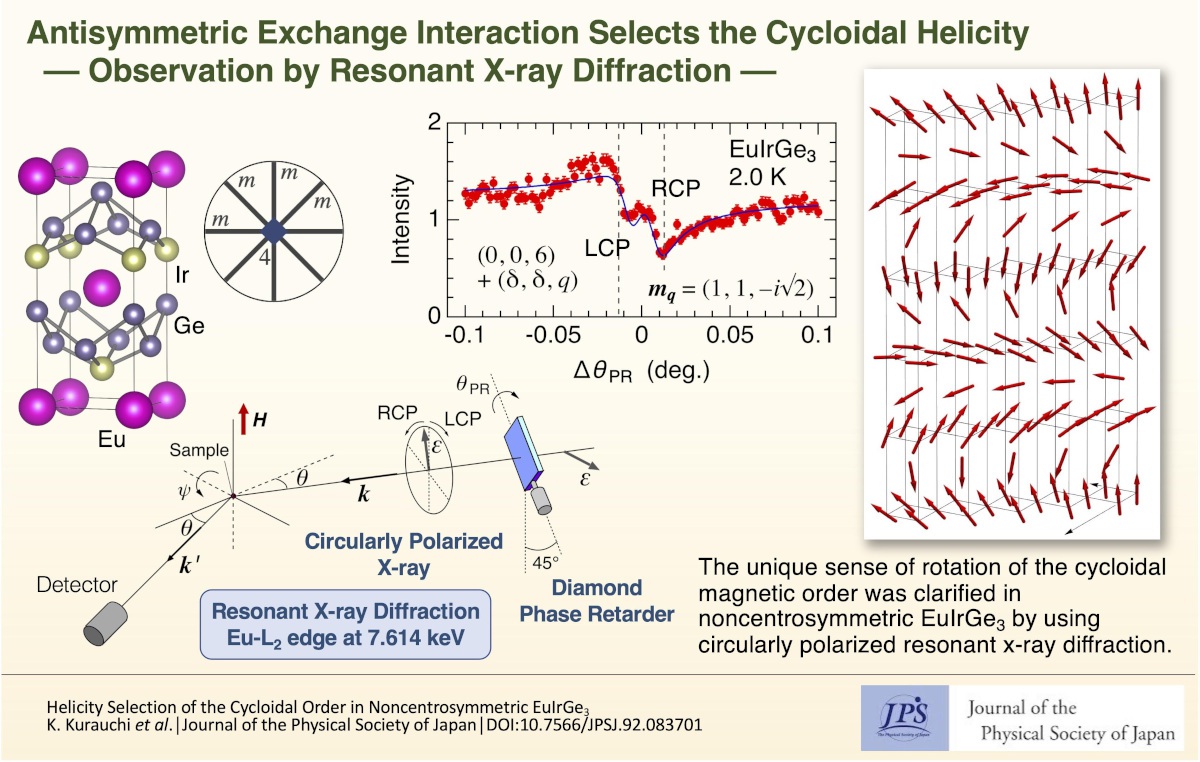Antisymmetric Exchange Interaction Selects the Cycloidal Helicity: Observation by Resonant X-ray Diffraction
© The Physical Society of Japan
This article is on
Helicity Selection of the Cycloidal Order in Noncentrosymmetric EuIrGe3
J. Phys. Soc. Jpn.
92,
083701
(2023)
.
The unique sense of rotation of the cycloidal magnetic order was clarified in noncentrosymmetric EuIrGe3 by using circularly polarized resonant x-ray diffraction.

In crystals lacking space inversion symmetry, antisymmetric exchange interactions can arise, which are generally expressed in the form of D • (Si x Sj). In normal magnetic ordering by symmetric exchange interactions of the form J Si•Sj, the magnetic moments are aligned parallel or antiparallel to each other into a collinear structure. However, when the antisymmetric exchange is active, the magnetic moments experience a twisting force, resulting in various types of spiral magnetic orderings. The twisting nature of exchange interactions has recently attracted considerable attention because it often generates nontrivial emergent magnetic structures such as chiral soliton lattices and magnetic skyrmion lattices. They are the crystallization of particle-like spin-swirling objects composed of spiral magnetic modulation waves with a single sense of rotation (helicity), which is considered to be the source of topological stability. Therefore, it is important to observe the helicity of the component waves.
The experimental observation of the magnetic helicity is challenging. Although polarized neutron diffraction is a powerful technique, it requires a delicate instrumental setup. In addition, it is unsuitable for samples that contain neutron-absorbing elements such as Eu and Gd. In this study, we employed resonant X-ray diffraction using a synchrotron radiation photon source. We used a diamond phase-retarder system inserted in the incident beam path to manipulate the incident polarization to left- and right-handed circularly polarized states, which have direct sensitivity to the magnetic helicity through different scattering cross-sections for the opposite sense of rotation. We applied a phase-retarder scan to observe the cycloidal ordering in the noncentrosymmetric magnet EuIrGe3, with four mirror reflection planes including the four-fold c-axis.
The cycloidal ordering is characterized by a propagation vector (δ, δ, 0.8), where δ=0.012 at 2.0 K. The Fourier component for this structure is either (1, 1, i√2) or (1, 1, - i √2), where the sign is related to the cycloidal helicity. Furthermore, there arise four magnetic domains described by (δ, δ, 0.8), (-δ, δ, 0.8), (-δ, -δ, 0.8), and (δ, -δ, 0.8). The helicities of all the four domains were measured.
The helicities perfectly reflected the C4v symmetry of the crystal structure. All four Fourier components were related by the 90° rotations and by the mirror reflections. This result clearly shows that the helicity of the cycloid is uniquely selected by the antisymmetric interactions. We believe that this method can be widely applied to the helicity measurements of various types of spiral magnetic systems.
(Written by T. Matsumura on behalf of all the authors.)
Helicity Selection of the Cycloidal Order in Noncentrosymmetric EuIrGe3
J. Phys. Soc. Jpn.
92,
083701
(2023)
.
Share this topic
Fields
Related Articles
-
Higher-Order Topological Phases in Magnetic Materials with Breathing Pyrochlore Structures
Electronic structure and electrical properties of surfaces and nanostructures
Magnetic properties in condensed matter
Mathematical methods, classical and quantum physics, relativity, gravitation, numerical simulation, computational modeling
2025-4-7
A simple example of a higher-order topological phase, in which the symmetry decreases step-by-step from the bulk to the corner, is realized in a magnetic system with a pyrochlore structure and is characterized by a series of quantized Berry phases defined for the bulk, surface, and edge.
-
Existence of Chiral Soliton Lattices (CSLs) in Chiral Helimagnet Yb(Ni1-xCux)3Al9
Magnetic properties in condensed matter
2025-4-1
Our study examines the magnetic structure of the monoaxial chiral helimagnet Yb(Ni1-xCux)3Al9, providing first direct evidence of the formation of chiral soliton lattice state.
-
Understanding Pressure-Induced Superconductivity in CrAs and MnP
Magnetic properties in condensed matter
2025-3-10
This study reviews existing research on the pressure-induced variation of magnetic properties of transition metal mono-pnictides like CrAS, MnP, and others, aiming to understand the unconventional superconductivity observed in CrAs and MnP.
-
Symmetry and AI: Building the Future of Physics Simulations
Magnetic properties in condensed matter
Measurement, instrumentation, and techniques
2025-2-18
Generative artificial intelligence (AI) has gained considerable attention in scientific fields. By embedding physical symmetry into AI before training, we created a faster and lighter model. Scaling improves the accuracy and unlocks the potential of physics research and applications.
-
Triangular Lattice Magnet GdGa2: Spin Cycloids and Skyrmions
Cross-disciplinary physics and related areas of science and technology
Electronic transport in condensed matter
Magnetic properties in condensed matter
2025-2-3
Careful measurements were conducted on the hexagonal magnet GdGa2 to reveal the experimental signatures of ultrasmall spin cycloids and of a potential Néel-type skyrmion lattice phase induced by a magnetic field.




